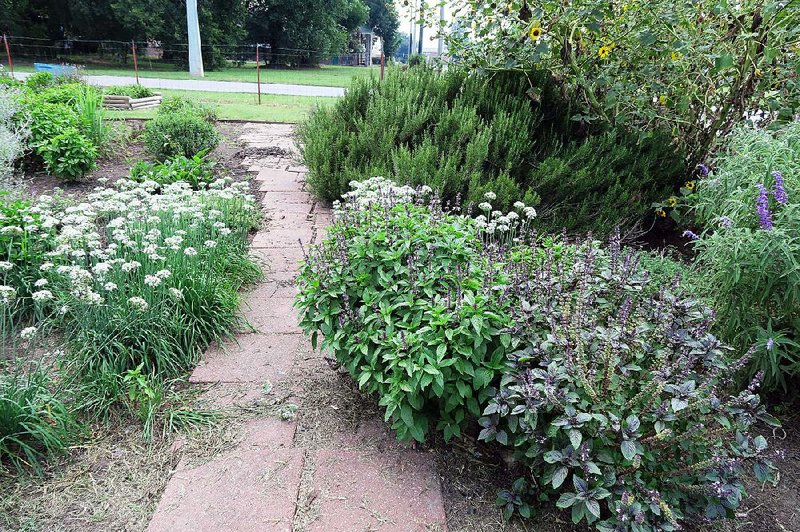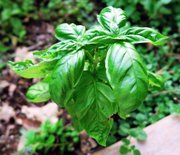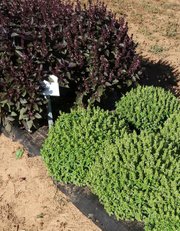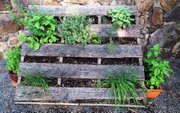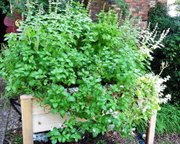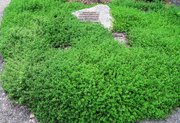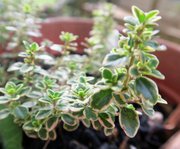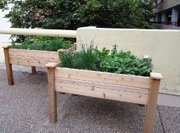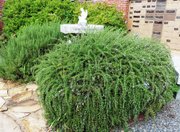Back when "parsley, sage, rosemary and thyme" was a lyric in a popular song, the herbs were known in Arkansas kitchens as little glass jars of dry powders or leafy bits. Today, fresh herbs are commonplace in kitchens and grown at home, too.
You can buy small bags or bundles of fresh herbs at the grocery store and at farmers markets. But those cut herbs don't last long once you get them home. Why not grow your own?
Herb gardens are as popular as perennial gardens these days, and in many cases, easier to grow. Whether you are an experienced gardener or a novice, you'll find herbs are easy to care for, with very few diseases or insects. They can be grown in a stand-alone garden dedicated to herbs or interspersed with flowers or vegetables.
Herbs may be annual or perennial plants, or grown as houseplants.
• Annual herbs are those that you must replant every season, as they complete their life cycle in one season. Annuals include basil, dill and cilantro. Some do better in cooler weather -- such as cilantro, dill and parsley -- while others thrive in the warm months, like basil and summer savory.
• Perennial herbs will come back for more than one year, and some can last a lifetime. Some die back to the ground, while others stay green year-round.
Parsley is really a biennial, taking two seasons to complete its life cycle, but most gardeners treat it as an annual.
JUST A PINCH
If you are new to growing herbs, you may want to start out with those you use the most in cooking. As you have success, add others.
Most herbs do best in a sunny, well-drained location. Planting them close to your kitchen makes a quick harvest easier and their use more likely.
Herbs can also be grown in containers. In a mixed pot of herbs or mixed in with summer annuals, they can grow and produce an abundant supply.
Herb gardens are as beautiful as they are functional. Herbs come in a variety of colors, heights and textures. Many have pleasing blooms along with their wonderful fragrances. Designing with herbs is a whole new way to incorporate herbs in the landscape.
If you don't want all herbs, mix them in with traditional landscaping. Take precautions if mixing herbs in with other plants -- avoid using pesticide near herbs. You will be eating the entire plant's parts, and many have fuzzy or crinkled leaves that will catch and hold overspray. Don't plant herbs for culinary uses near pesticide-needy plants.
FROM SCRATCH
If you are starting a new herb garden, you can begin with seed or transplants. Most nurseries carry a wonderful selection of herb plants. Although the plants start out small, they will grow and need space. Know something about the expected mature size. When deciding on plant spacing, allow room for continued growth, or interplant with annuals that won't be around to need the space next season.
How many of each herb plant you'll need will depend on how much you will use that herb, and how large the plant will become. Many gardeners today are planting herbs for culinary enjoyment and also to attract butterflies. You may need to plant enough parsley and fennel for you and the caterpillars.
Some plants are also more aggressive than others. A single mint plant can take care of all of your mint needs and then some. If you end up producing too much of one herb, freeze it or dry it for later use, or share some with a friend.
BASIL
The most common annual herb grown and used today is basil. Basil is a heat lover and thrives outdoors all summer long. There are many different species of basils, from the common sweet basil and a dark purple "Purple Ruffles" to Thai basil and "Little Leaf" basil.
There are also flavored basils, including lemon, lime and cinnamon.
Give basil a spot in the sun and water as needed during the summer. The more often you harvest, the better the plant will grow. The key is to prevent it from blooming. If you allow it to bloom, it will start to set seeds, and you won't get as many leaves to use.
CILANTRO
Cilantro is an annual herb you either love or hate. In the United States we call the foliage cilantro and the seeds coriander. In the United Kingdom, it is called coriander in both forms.
A common problem gardeners have is planting it too late in the spring. Cilantro grows best in cool weather and if exposed to higher temperatures it quickly bolts -- sets seeds -- and its season is over.
Plant it in the fall to grow with your winter annuals of pansies and violas. Except for the far northern part of the state, it should overwinter outdoors quite nicely.
Another planting in early spring can extend your harvest season.
PARSLEY
Parsley is a biennial: You get foliage the first season, and the second season, it blooms, sets seeds and dies.
Planting some in spring and in fall will give you fresh parsley year-round.
Growing parsley from seed can be challenging, but it is readily available as plants at most garden centers, and usually sold spring and fall.
Some cooks prefer the flat leaf parsley over the curly leaf, but both grow well in Arkansas gardens.
PERENNIALS
Some perennials to try include chives, rosemary, sage, thyme and oregano.
Rosemary is now being planted as a drought-tolerant evergreen shrub. There are many varieties of this popular herb, from prostrate forms to uprights. Hardiness can vary by variety. The past cold winter did cause some damage to these plants, but most have rebounded.
Foliage and flowers are both used in cooking.
Make sure the site is well drained -- rosemary will not tolerate heavy, poorly drained soils and it actually thrives in poor, rocky sites.
Another evergreen herb that thrives on neglect is thyme, which is also one of the most heat and drought tolerant plants around.
As with many of the other herbs mentioned, there are many varieties from which to choose. All have small, dainty leaves and grow close to the ground, but you can get green and variegated forms.
Thyme prefers a dry site in the sun. If grown near a sprinkler head it won't be happy. Thyme can be grown as a ground cover, planted around stepping stones, used as a low border to a garden or even in containers.
GOOD COMPANY
The list of herbs goes on and on. When planting, make sure you are grouping plants with similar needs together -- sun, shade, wet or dry. Some herbs are easy to grow, getting sometimes too vigorous (some of the mints). Containers can prevent problems.
Probably the best part of herb growing is the harvesting. You don't have to wait months to reap your rewards, since you can start harvesting the day you plant. Be more judicious in your pruning of perennial herbs than you are with annuals, since you need them to live longer.
• For annuals, frequent harvesting results in fuller plants and more foliage. Harvest all of the plant before a cold snap for the heat lovers and before they bolt for the cool-season growers.
• For perennials, never remove more than a third of the foliage, and only harvest what you need at one time.
The best time to cut fresh herbs is in the morning after the dew dries and before midday heat hits, or in the evening as it cools down.
Experiment with herbs. Cooking with fresh herbs is a little different from using them dried. Dried herbs are more concentrated in flavor than fresh herbs. In recipes you will usually use three times the amount called for when using fresh than dried, but experiment -- you can always add more.
Herbs are supposed to complement your food, not mask it.
Fresh herbs must be used within a few days or they quickly diminish in quality. Store fresh basil and cilantro in a vase of water on the counter to help it last as long as possible.
Herb gardening is a fun and rewarding hobby and a boon for any cook. Herbs give you fragrance, taste and a beautiful plant all in one package. So whether you are a new gardener or an experienced one, add some herbs to your garden.
Janet B. Carson is a horticulture specialist for the University of Arkansas Cooperative Extension Service.
HomeStyle on 07/21/2018
